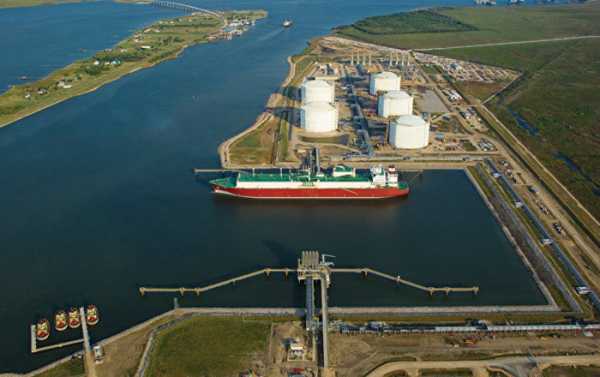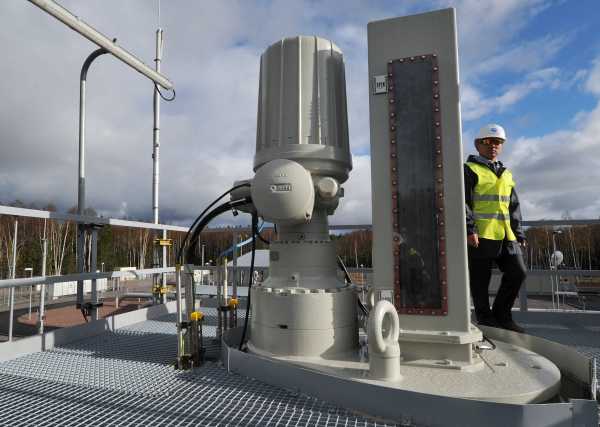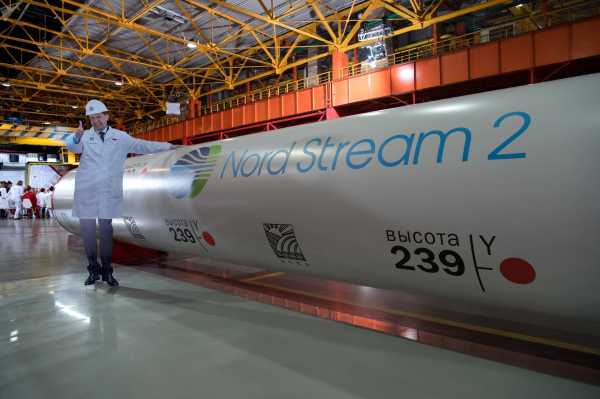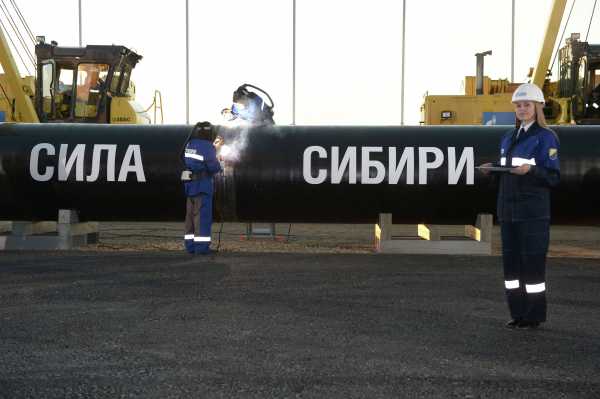
According to some estimates, the US will probably become one of the largest exporters of LNG by 2020. However, it seems that Washington seeks to use its liquefied hydrocarbons as an economic weapon against their geopolitical rivals Russia and China.
Washington munition of its liquefied natural gas (LNG) supplies to kill two birds with one stone — to expel Russia from the European energy market and to win the “trade war” with China.
After the February revolution of 2014 in Ukraine and the reunification of the Crimea with Russia, the administration of Barack Obama, the 44th President of the United States, urged member countries of the EU to reduce its dependence on Russian gas, citing “security reasons”.
Speaking in March, the EU-US summit 2014 in Brussels, Obama urged European allies to hasten the conclusion of the controversial Transatlantic trade and investment partnership (TTIP), we propose liquefied natural gas (LNG) in exchange.
“Once we have a trade agreement in place, export licenses for projects for liquefied natural gas destined for Europe will be much easier, something that is obviously relevant in today’s geopolitical environment,” Obama said in response to then-President of the European Commission Jose Manuel Barroso’s call for accelerated us export gas.
View of American LNG as a potential tool in the competition for the energy market of the EU, Washington focused on developing LNG plants on their territory.
The country began exports of liquefied hydrocarbons from the lower 48 States on a large scale after the terminal Sabine Pass, Louisiana began operations in February 2016.
According to the energy information Administration US (EIA), we have five additional LNG projects “is expected to increase overall liquefaction potential of the U.S. to 9.6 kBq/g by the end of 2019.”
In October 2017, the energy research Institute (IEI) predicted that the USA will soon become a major exporter of LNG: “between 2016 and 2020, the United States is expected to account for about half of the 20 billion cubic feet a day of LNG export capacity around the world,” the IER study said, adding that “the world’s LNG demand is now about 37 billion cubic feet per day.”
This automatically means that U.S. LNG is likely to come out on top in the European market in the near future?
U.S. LNG supplies to Europe are close to Gazprom: Russian gas giant made in the amount of 194,4 billion cubic meters of gas to Europe in 2017, according to “Gazprom export” website, compared with around 72.9 billion cubic feet (2.26 billion cubic meters) of LNG delivered to the United States on the old continent (Italy, Lithuania, Malta, Netherlands, Poland, Portugal, Spain and the UK), how EIA estimates.

The launch of the second line of the pipeline “Nord stream”
For comparison, while in the 2017 America lists 3.4 billion cubic feet (0.097 billion cubic meters) of natural gas in Poland, a vocal antagonist of the Gazprom Nord stream 2, Russia has provided Warsaw with 10.47 billion cubic meters of hydrocarbons.
The reason for this imbalance is clear: the price of American LNG in Europe is about 1-2 $higher North European-level gas prices, Oilprice.com said in June last year.
The media also said that the Russian “Gazprom” in America is not the only competitor in the energy market of the EU — in the case that the Russian gas producer, driven out of Europe, TRANS Adriatic pipeline can replace it and deliver Caspian gas to the old continent; meanwhile, Qatar remains the largest exporter of LNG.
Donald trump: Anti-Russian sanctions and refocusing on China
The domination of Donald trump in the presidency was marked by a tightened sanctions regime against Russia, Iran and North Korea, which was signed into law August 2, 2017. A new round of sanctions over alleged Russian interference in the 2016 presidential elections in the United States and an agreement with trump, which they vehemently rejected, potentially target companies in the European Union, participating in the implementation of the gas project is 11 billion Nord $2 stream.
Earlier, Austria and Germany, two countries involved in “Gazprom” -the initiative to build a pipeline system under the Baltic sea, has criticized American politicians, seeking their own United States interested in exporting gas to Europe.
“Energy supplies to Europe-is a matter for Europe, not the United States of America”, – said the foreign Minister of Germany Sigmar Gabriel and the Austrian Chancellor Christian Kern said in a joint statement.
In turn, Gazprom Deputy Chairman Alexander Medvedev said: “as for sanctions, they do not hide that this measure is aimed at ensuring American LNG to Europe.”
However, after the imposition of sanctions, Gazprom has signaled that it will perform its obligations in spite of everything: “according to preliminary estimates, this does not diminish the opportunities for “Gazprom” external borrowing”, – said Alexander Ivannikov, Gazprom official noted, stressing that the law could be broadly interpreted.

The Chairman of the Board of OJSC “Gazprom” Alexey Miller visited ETERNO the workshop of the Chelyabinsk pipe rolling plant
Despite the efforts of the United States’ Central and Eastern European allies to throw sand in the wheels of the Nord stream 2, Berlin continues to promote the project: March 27, 2 Nord stream AG received the full set of permits in Germany for the construction and operation of the pipeline system.
Earlier, in January 2018 the international observers were caught by surprise when the first batch of Russian LNG produced at the plant “Yamal LNG” has arrived in the us city of Boston, the tanker French company engie, despite the sanctions regime by the US. They were even more surprised when the second shipment of Russian LNG reached the American shores.
Given all the above, it is not surprising that trump decided to turn to the East, strengthening the core of Washington to China.
According to KSP, a Chinese natural gas demand could reach in 2020 to 330 billion cubic meters (11.65 trillion cubic feet).
Now Mexico, South Korea and China remain the main destinations for us hydrocarbons, receiving about 53 percent of U.S. LNG exports. European countries together account for only the third largest share of LNG exports from the United States after Asia and North America (Mexico), according to the EIA.
It seems that President trump and the Minister of Commerce Wilbur Ross decided to use us as a tool of export of LNG in the impending trade war with Beijing.
Since trump took over as President, the two countries have been involved in a dispute over U.S.-China trade deficit, which grew in 2017 375.2 billion. Having imposed additional duty on steel and aluminium exports, the White house announced its intention to impose duties on Chinese imports amounting to $ 60 billion.
In addition, Secretary Ross addressed the Chinese last week, arguing that the best way for Beijing to reduce its trade deficit with the US more to buy American LNG.
“China needs to import very, very large volumes of LNG and from their point it would be very logical to import it from USA, if for no reason other than to diversify their sources of supply. It will also have the side effect of reducing the deficit,” Ross said, as reported by Bloomberg.
China became the second after Europe to get an ultimatum from Washington to the us to buy the hydrocarbons in exchange for better relations. However, it seems that after the EU, for example, Beijing did not sacrifice its national interests and would rather rely on the Chinese-Russian gas pipeline “power of Siberia”, which should be commissioned in December 2019 than we are LNG supplies to ensure its energy security.

The gas pipeline “power of Siberia”
Threats the CIA and the Soviet gas pipeline”
Russian natural gas resources have long been a thorn in the side of the US. A few decades ago, in 1982, a special national estimates of the CIA entitled “Soviet gas pipeline in perspective,” predicted that the Soviet Union will increase gas exports to the West in the near future.
“To date, the most promising for export expansion in the vast resources of the West Siberian natural gas”, – the document says. “The proven gas reserves in Siberia are not enough to cover any likely increase in the total energy consumption in the USSR in 1980-x and 1990-ies, as well as a significant increase in gas exports to the West.”
According to the document, the Soviet Union began delivery of natural gas to Western Europe in the early 1970’s: “between 1968 and 1975, Moscow had concluded eight ‘gas pipe agreements with Austria, France, Italy and West Germany”. Some contracts provide for gas supplies to the USSR until 2000.
Trying to prevent the construction of the Soviet pipeline to Western Europe, the Reagan administration imposed an embargo on American goods and technology which could contribute to the completion of the project. However, the movement caused a split between the United States and its European NATO allies, which led to the lifting of sanctions on November 13, 1982.
However, referring to the new memoir of the Reagan White house official, Thomas reed, the Washington post wrote in 2004 that the Reagan administration will not abandon their plans to sabotage the Siberian gas route and ordered the CIA in January 1982, to provide the Russians with the technology that contained hidden malfunctions. According to reed, the alleged operation resulted in a huge explosion in a Siberian highway.
Decades later, we dug out the ax of the gas war with Russia.
Sourse: sputniknews.com






